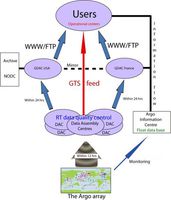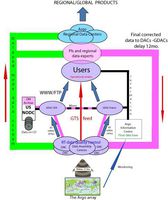When a float surfaces the data are transmitted and the float's position determined (mostly through Système Argos). The information on the development of the float array is monitored by the Argo Information Centre in Toulouse. This information is then received by national data centers. Here they are subjected to initial scrutiny where erroneous data are flagged and/or corrected and the data are passed to Argo's two Global Data Assembly Centers (GDACS) in Brest, France and Monterey, California. This is the first stage at which the data are publicly available. They are available from the GDACs to anyone wanting to use them. Most users obtain data from the GDACs via the internet. The GDACs synchronize their data holdings to ensure consistent data is available on both sites. The data reach operational ocean and climate forecast/analysis centers via the Global Telecommunications System (GTS).
The target is for these "real-time" data to be available within approximately 24 hours of their transmission from the float.
In addition to the real-time data stream, Argo has the potential, after careful data assessment, to provide salinity/temperature/pressure profiles that approach ship-based data accuracy.
In general there is no possibility of carrying out calibration checks on a float's sensors after it has left the laboratory or has been launched by a research ship that might make a nearby CTD cast. One means of adjusting salinities is to look at deviations of the float data from a stable, deep temperature/salinity climatology [Wong et al., 2003], or to compare profiles from floats that coincide in space and time. The Wong et al method has been adopted by Argo as its standard means of delayed mode data quality control. The delayed-mode quality control is the responsibility of researchers in each country in collaboration with the appropriate national data center. It has been recommended that delayed mode data inspection is carried out on a 1 year long record so that sudden jumps in calibration may be distinguished from long term drift or water mass property changes. This imposes a minimum 6 month delay on the availability of delayed mode data.
This system was adopted in 2004 and is now being applied to Argo data. These delayed-mode data are currently available from the GDACs.
An additional phase of Argo data management occurs at a regional level at the Argo Regional Centers (ARCs). This enables the accumulation of consistent regional data sets and the production of Argo based products. To learn more about the Argo Regional Centers, go to ARC page.
The Argo Information Centre is a source of information about the development and performance of the global array and the national programmes that contribute to it.
The final repository for Argo data is with the US National Oceanographic Data Center ( NODC ). They will also distribute Argo data on CDs so as to permit Argo data use by groups without reliable or low cost internet access.


